Imagine this: You’re standing at the edge of a pristine forest, breathing in the crisp mountain air—when you spot a discarded plastic water bottle glinting in the sun. Suddenly, your adventure feels at odds with the environment you love. The truth? Outdoor enthusiasts generate millions of tons of gear waste yearly, from single-use plastics to abandoned tents. But what if you could explore nature without leaving a trace? That’s where sustainable outdoor accessories come in.
These eco-conscious upgrades aren’t just better for the planet—they’re more durable, ethically made, and often save you money long-term.
In this guide, we’ll cover the 7 must-have sustainable outdoor accessories, handpicked for:
- Minimal environmental impact (think recycled materials, biodegradable options).
- Real-world performance (no greenwashing—just gear that works).
- Ethical brands that align with your values.
Whether you’re a weekend hiker, a camping pro, or just dipping your toes into eco-friendly travel, these picks will help you adventure responsibly—without sacrificing quality.
Let’s dive in!
What Makes an Outdoor Accessory Sustainable?
The outdoor industry is full of “eco-friendly” claims, but not all gear lives up to its promises.
To help you make informed choices, let’s break down the key criteria that define real sustainability in outdoor accessories.
1. Materials: The Foundation of Eco-Conscious Gear
Not all fabrics are created equal. Truly sustainable outdoor gear uses:
- Recycled materials (like ocean plastics turned into backpacks or fleece)
- Natural fibers (organic cotton, hemp, or bamboo for clothing and gear)
- Innovative alternatives (cork, mushroom leather, or biodegradable synthetics)
Why it matters: Virgin plastics and resource-heavy materials contribute to pollution and waste. Choosing recycled or plant-based options reduces your footprint.
2. Ethical Production: Beyond the Product
Sustainability isn’t just about materials—it’s about how gear is made.
Look for:
- Fair Trade or B Corp-certified brands (ensuring fair wages and safe conditions)
- Carbon-neutral shipping and manufacturing (brands that offset emissions)
- Local production (reducing transport-related emissions)
Pro Tip: Brands that openly share their supply chain details (like Patagonia or Cotopaxi) are usually more trustworthy.
3. Durability: The Most Overlooked Factor
The most sustainable outdoor accessory is gear that lasts. Prioritize:
- Lifetime warranties (like Fjällräven’s repair program)
- Modular designs (zippers, straps, and buckles that can be replaced)
- Timeless functionality (avoiding fast-fashion outdoor trends)
Did you know? A single high-quality backpack that lasts 10 years creates less waste than 3 cheap ones that fall apart.
4. Certifications to Look For
Cut through greenwashing by checking for:
- Bluesign® (ensures safe, sustainable textile production)
- Global Recycled Standard (GRS) (verifies recycled content)
- OEKO-TEX® (confirms non-toxic materials)
5. End-of-Life Responsibility
A truly sustainable brand thinks about what happens after you stop using the product. The best ones offer:
- Take-back or recycling programs (like REI’s used gear trade-in)
- Compostable or plastic-free packaging
Why This Matters for Your Next Purchase
Understanding these factors helps you spot real sustainable gear—not just clever marketing.
Now that you know what to look for, let’s dive into the 7 must-have sustainable outdoor accessories that meet these high standards.
Want a quick tip before we continue? Always check the brand’s “About” or “Sustainability” page. If their commitments are vague, think twice before buying.
You May Also Read: What is Sustainable Travel (HOW TO DO IT – 13 Proven Ways)
7 Must-Have Sustainable Outdoor Accessories
The right gear can make or break your outdoor experience—but it shouldn’t come at the planet’s expense.
After testing, researching, and analyzing sustainability reports, we’ve curated the 7 best eco-friendly outdoor accessories that deliver top performance without harming the environment.
Each pick meets strict criteria:
a. Made from recycled/plant-based materials
b. Produced ethically (fair wages, low carbon footprint)
c. Built to last (avoiding disposable culture)
d. From transparent brands you can trust
Did you know 80% of outdoor gear ends up in landfills? If you love the outdoors but want to reduce your footprint, these sustainable outdoor accessories are for you.
You May Also Read: Best Hardshell Rooftop Tent: A Complete Guide
#1 Portable Solar Generator: Your Off-Grid Powerhouse
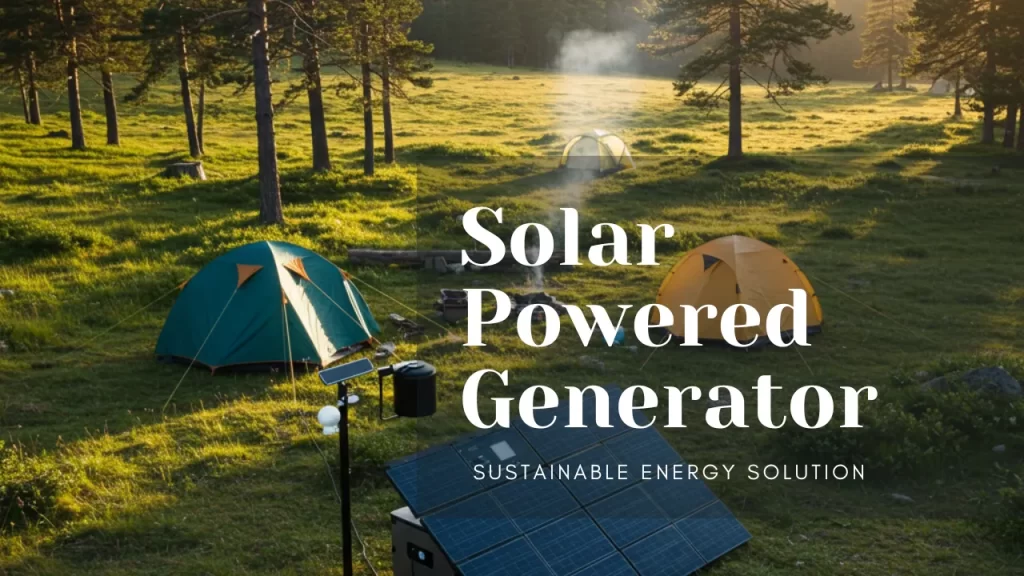
Picture this: It’s day 3 of your backcountry trip, and your phone, GPS, and camera are all charged up – without a single disposable battery or drop of gasoline. That’s the magic of a portable solar generator.
Unlike traditional gas generators that pollute and require constant refueling, these silent power stations harness the sun’s energy to keep you connected and safe.
You May Also Read: Your Comprehensive Guide to the Best Solar Generator for Off-Grid Living
Sustainable Advantages:
- Eliminates need for disposable batteries and gas-powered generators
- Solar-rechargeable design means zero ongoing fuel costs
- High-quality lithium batteries last for hundreds of cycles
- Modular design allows for easy repairs instead of replacement
Recommended Product:
Jackery Explorer 3000 Pro
This powerhouse delivers:
- 3024Wh capacity (powers fridges, CPAP machines, and more)
- Charges in 3.5 hours via solar
- Ultra-quiet (30dB) and emission-free
- Smart display shows input/output and battery status
Best For: Campers, RVers, and emergency prep.
You May Also Read: Top-Rated Solar Generator for RV: Unlocking the Secret to Unlimited Power
#2 Recycled & Biodegradable Backpack
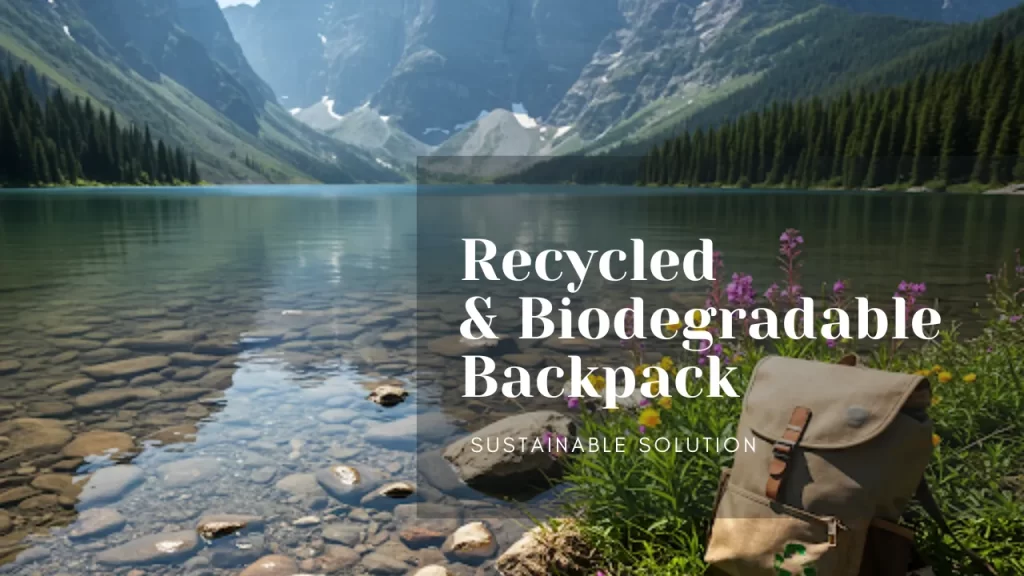
Every outdoor adventure starts with what you carry your gear in. Most backpacks are made from virgin plastics that will outlive us by centuries.
Sustainable backpacks now offer the same durability as conventional options while using recycled materials and non-toxic treatments. The best designs even consider end-of-life recyclability without sacrificing weather resistance or comfort.
You May Also Read: 5 Items That Are Usually Recycled (And How to Do It Right)
Why It’s Sustainable:
- Made from recycled ocean plastics or natural materials
- PFC-free waterproof coatings that actually work
- Reinforced construction that lasts for years of heavy use
- Fully recyclable through manufacturer take-back programs.
Recommended Product:
Patagonia Arbor Roll-Top Pack
Why it stands out:
a. 30D nylon made from recycled fishing nets
b. Weather-resistant without harmful chemicals
c. Adjustable roll-top fits variable loads
d. Lifetime guarantee with repair services
Best For: Day hikers, climbers, and daily commuters.
#3 Stainless Steel Collapsible Water Bottle – Ditch Single-Use Plastic
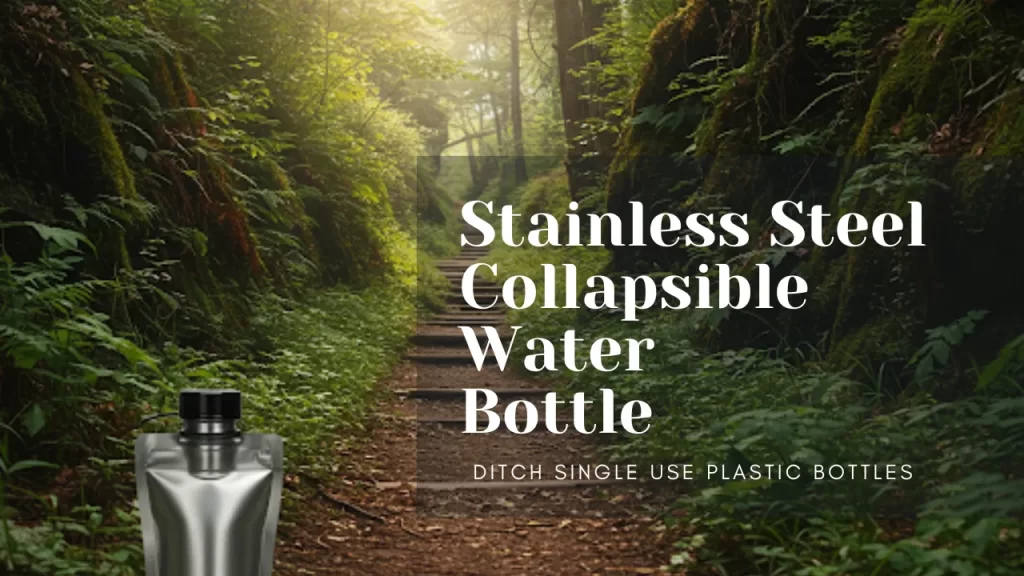
Hydration is non-negotiable in the outdoors, but plastic bottles have no place on the trail. Modern collapsible bottles solve the packability issue that kept many adventurers reaching for disposables.
These innovative designs collapse when empty but maintain the purity and insulation of premium water bottles. The best models are tough enough for backcountry use while being light enough for ultralight packing.
Sustainable Advantages:
Eliminates hundreds of single-use bottles over its lifetime
Non-toxic materials that won’t leach chemicals
Durable enough for decades of daily use
Space-saving when not in use
You May Also Read: Visual Comparison of Biodegradable Vs. Non-Biodegradable Biomaterials
Recommended Product:
Hydro Flask Lightweight Trail Series
Key features:
a. Collapses from 24oz to just 2 inches thick
b. Double-wall vacuum insulation maintains temperature
c. BPA-free stainless steel construction
d. Secure carabiner loop for easy attachment
Best For: Backpackers, travelers, and everyday use.
#4 Sustainable Sleeping Bag – Stay Warm, Sleep Green
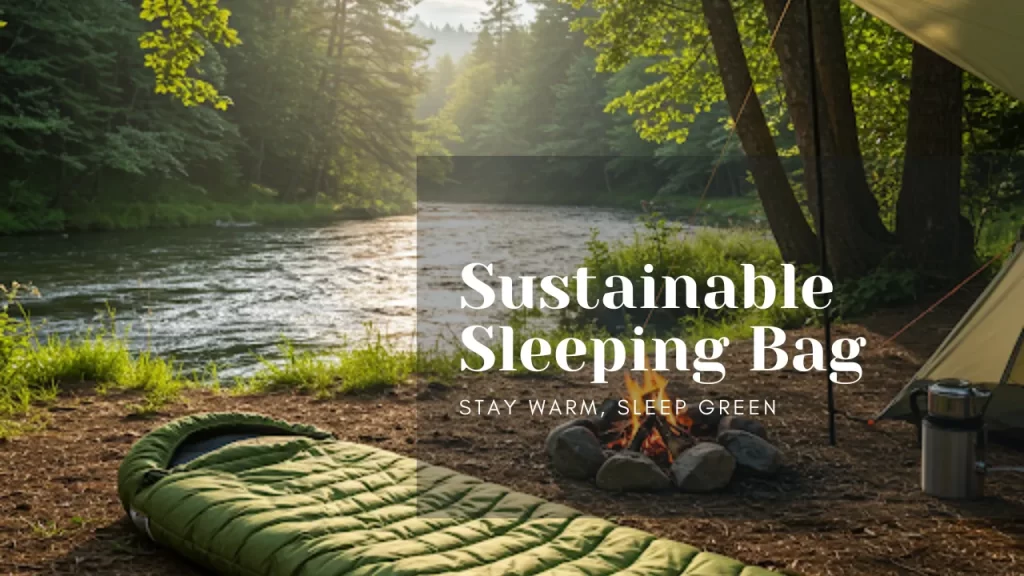
Your sleeping bag is your most intimate gear – it literally surrounds you all night. Conventional bags often contain environmentally harmful treatments and non-recyclable materials.
The new generation of eco-conscious sleeping bags proves you don’t need to compromise warmth for sustainability. From recycled shells to responsibly-sourced insulation, these bags perform as well as conventional options while leaving a lighter footprint.
Sustainable Advantages:
a. Recycled shell and lining materials
b. PFC-free water repellent treatments
c. Responsible down or plant-based insulation
d. Designed for repair and eventual recycling
You May Also Read: The Ultimate Guide to Choosing the Perfect Hammock Camping Chair (Top 7 Products Reviewed)
Recommended Product:
The North Face Eco Trail Sleeping Bag
Why we recommend it:
a. 100% recycled materials throughout
b. 600-fill Responsible Down Standard certified insulation
c. Recyclable through TNF’s Renewed program
d. Compresses small without losing loft
Best For: Backcountry camping and cold-weather adventures.
#5 Bamboo Utensil Set: Say No to Single-Use Plastic
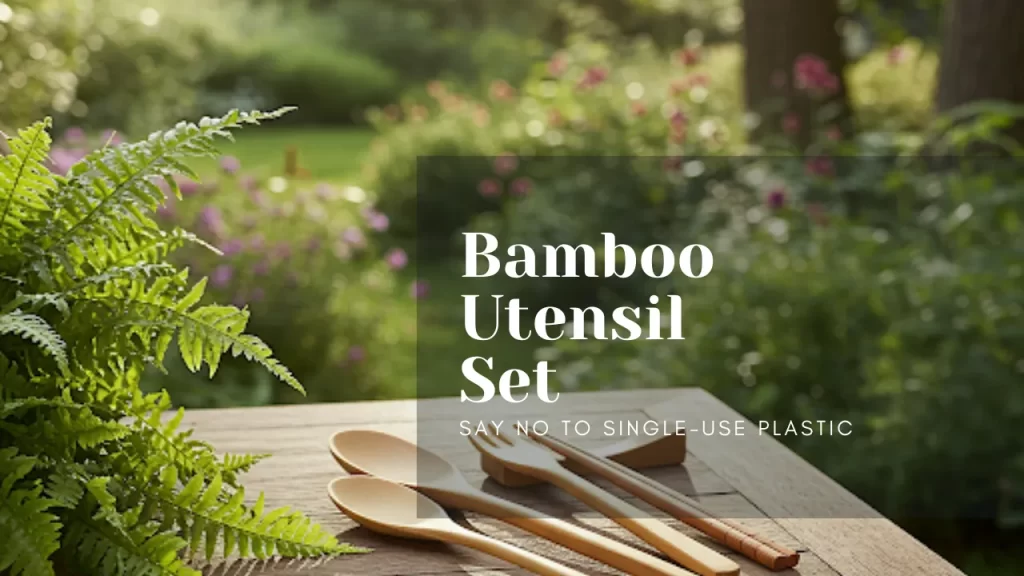
There’s nothing worse than sitting down to a beautiful backcountry meal only to realize you’re stuck with flimsy plastic utensils that snap halfway through your dinner. Bamboo utensil sets solve this problem while keeping tons of plastic waste out of landfills and off our trails.
These lightweight sets combine the durability of metal with the sustainability of fast-growing bamboo. Unlike cheap camping sporks that bend or break, quality bamboo utensils can last for years of regular use while being gentle on your cookware.
You May Also Read: 5 Top Picks: Your Ultimate Guide to Reusable Paper Towels
Sustainable Advantages:
a. Made from rapidly renewable bamboo (grows up to 1 meter per day!)
b. Naturally antimicrobial properties
c. Fully compostable at end of life
d. Replaces hundreds of disposable utensils
Recommended Product:
To-Go Ware Bamboo Travel Utensil Set
Why it’s our top pick:
a. Complete 4-piece set (spoon, fork, knife + chopsticks)
b. Stainless steel utensil ends for cutting tough foods
c. Organic cotton carrying case doubles as cleaning cloth
d. Rounded edges make them kid-friendly
Best For: Backpacking trips, picnics, office lunches, and festival camping
You May Also Read: 7 Must-Have Zero Waste Kitchen Essentials for 2025
#6 Ethical Rain Jacket –Weatherproof Without the Waste
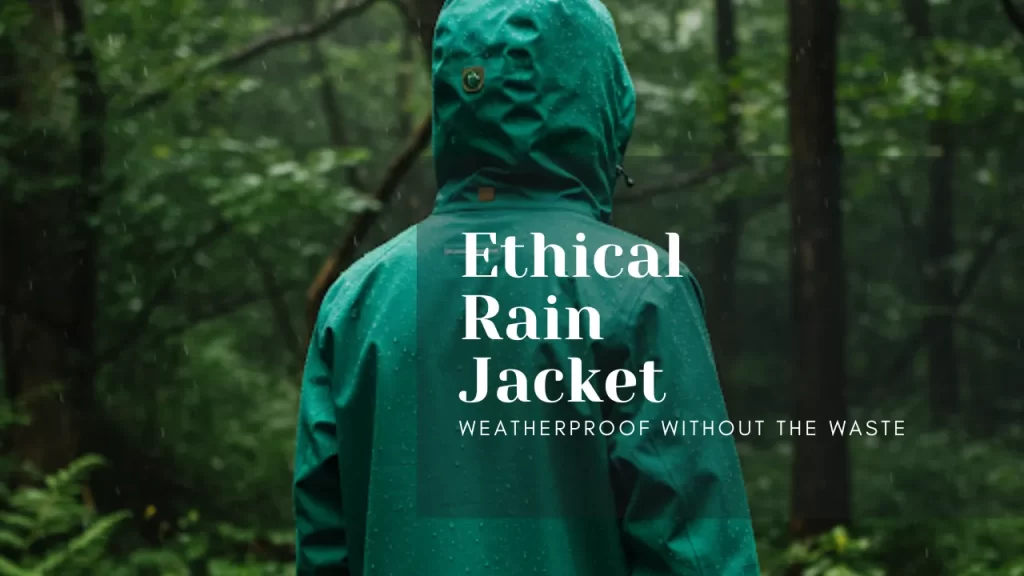
Most rain jackets are environmental disasters disguised as outdoor gear. They’re typically made with virgin plastics and coated with toxic PFCs that never break down in nature. Sustainable rainwear proves you can stay dry without poisoning the planet.
The best eco-friendly rain jackets use recycled materials and innovative PFC-free waterproofing that actually works. They’re designed for years of use rather than seasonal replacement, with repair programs to extend their lifespan even further.
Sustainable Advantages:
a. Made from 100% recycled nylon or polyester
b. PFC-free DWR coatings that don’t bioaccumulate
c. Fair Trade Certified manufacturing
d. Fully recyclable at end of life
You May Also Read: Going Green on the Go: 11 Smart Strategies for Decreasing Your Travel Carbon Footprint
Recommended Product:
Patagonia Torrentshell 3L Jacket
Standout features:
a. 3-layer construction from recycled materials
b. Fully seam-sealed waterproof protection
c. Pit zips for ventilation during high output
d. Recyclable through Patagonia’s Worn Wear program
Best For: All-weather hiking, backpacking, and daily commutes
#7 Eco-Friendly Camping Hammock – Relax Responsibly
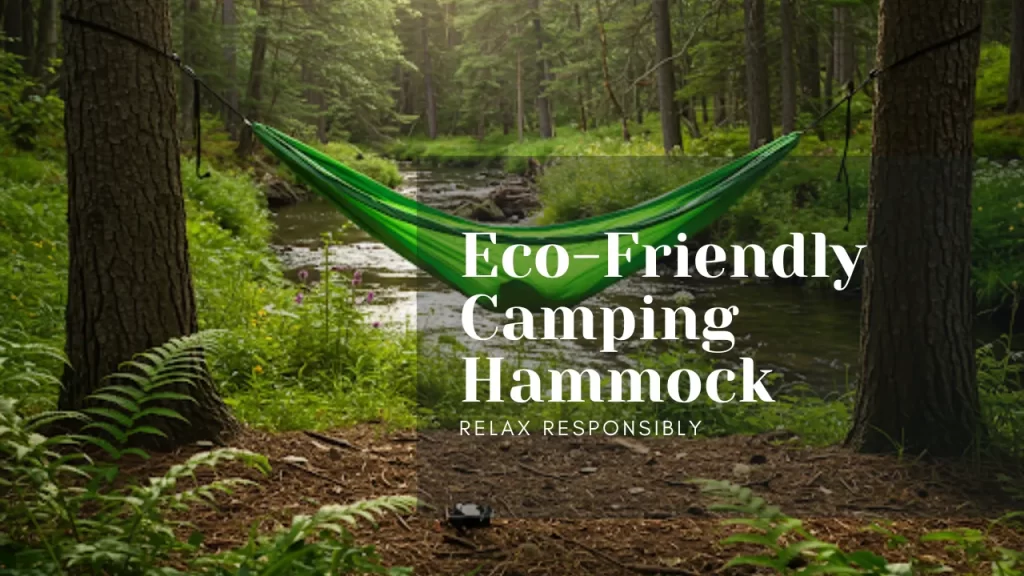
Hammocks have become essential gear for everything from backyard lounging to ultralight backpacking. But most are made from virgin nylon with tree-harming straps. Sustainable hammocks use recycled materials and innovative designs to minimize environmental impact.
The best eco-hammocks are just as comfortable and durable as conventional options while using a fraction of the resources to produce. They come with wide, protective tree straps and are built to last for years of adventure.
Sustainable Advantages:
a. Fabric made from recycled materials
b. No-stretch tree straps protect bark
c. Compact and lightweight for packing
d. Durable construction withstands years of use
You May Also Read: 27 Best Eco Friendly Travel Products
Recommended Product:
ENO SingleNest Hammock
Why we love it:
a. Made from 100% post-consumer recycled material
b. Includes 2-inch wide tree-saving straps
c. Holds up to 400 lbs despite lightweight design
d. Packs down to size of a grapefruit
Best For: Backyard chilling, beach trips, and ultralight backpacking
You May Also Read: AcoPower LiONCooler X40A Review: Don’t Buy Before Reading This
How to Choose the Right Sustainable Outdoor Accessories for Your Needs
Selecting eco-friendly outdoor accessories isn’t about buying everything labeled “green” – it’s about making strategic choices that align with your adventures and values. Here’s how to build a sustainable kit that works for you:
1. Match Gear to Your Adventure Style
- Weekend Warriors: Focus on high-use items like water bottles and daypacks
- Backcountry Campers: Prioritize sleeping systems and cooking gear
- Travel Adventurers: Look for versatile, packable items like collapsible gear
- Family Campers: Choose durable, kid-friendly options that will grow with your family
Pro Tip: Start by replacing items you use most frequently for maximum impact.
2. Understand Sustainability Priorities
Every product makes tradeoffs. Decide what matters most to you:
- Materials: Recycled content vs. natural fibers
- Production: Fair labor practices vs. local manufacturing
- Performance: Technical specs vs. multi-use functionality
- Lifespan: Repairability vs. compostability
3. Budget Wisely
Sustainable gear often costs more upfront but saves long-term:
- Investment Pieces (sleeping bags, jackets): Worth splurging on quality
- Affordable Swaps (utensils, bottles): Easy immediate changes
- Secondhand Options: Many outdoor retailers now sell refurbished gear
4. Spot Genuine Sustainability
Cut through greenwashing by looking for:
- Specific percentages of recycled materials
- Third-party certifications (Bluesign®, Fair Trade)
- Brand transparency about supply chains
- Repair programs and warranties
5. Consider Your Climate
- Wet environments: Focus on PFC-free waterproofing
- Cold climates: Prioritize responsible insulation
- Arid regions: Choose sun protection with mineral-based UV filters
6. Think Beyond the Purchase
- Maintenance: Proper care extends gear life dramatically
- End-of-Life: Choose brands with take-back programs
- Community: Share or borrow specialty items you use infrequently
Actionable Checklist:
1. ☐ Identify 2-3 most-used items to replace first
2. ☐ Research brands’ sustainability claims
3. ☐ Compare cost-per-use rather than just purchase price
4. ☐ Learn basic repair skills for your gear
5. ☐ Plan proper storage between seasons
Remember: The most sustainable gear is the gear you already own. If your current equipment works, keep using it! When replacements are needed, let these guidelines steer you toward choices that protect both your adventures and the planet.
Need personalized recommendations? Tell us about your typical outdoor activities in the comments, and we’ll suggest the most impactful sustainable swaps for your needs.
Bonus: DIY Sustainable Outdoor Hacks
♻️ Repurpose Old Gear – Give It New Life
Instead of tossing damaged equipment, get creative:
- Tent → Tote Bag: Waterproof fabric makes perfect grocery bags or gear storage
- Sleeping Pad → Knee Pad: Cut for gardening or workshop use
- Worn-Out Jacket → Dog Coat: Insulate your pup for winter walks
- Climbing Rope → Doormat: Braid for a durable, weatherproof mat
Pro Tip: Outdoor brands like Patagonia Worn Wear and REI Re/Supply often accept old gear for refurbishing or recycling.
Zero-Waste Camping Checklist
Pack these to leave no trace:
- Reusable Food Containers (silicone bags, beeswax wraps)
- Camp Soap & Scraper (wash dishes without polluting water sources)
- Cloth Napkins + Bandanas (replace paper towels)
- Bulk-Bin Snacks (pack in reusable containers)
- Solar Lantern (skip disposable batteries)
Extra Credit:
- Meal Plan Precisely to avoid food waste
- Pack Out All Trash (even compostables in bear country)
- Use Natural Markers (sticks/rocks) instead of tape or flags
Why This Matters:
The average camper generates 2.5 lbs of waste per day. These simple hacks can cut that to near zero while saving you money!
Got Your Own Hack? Share your favorite gear-repurposing idea below!
FAQs
1. What makes outdoor gear sustainable?
Sustainable outdoor gear uses recycled/plant-based materials, ethical manufacturing, and durable designs. Look for Bluesign® certification, recycled content (e.g., ocean plastics), and repair programs to verify claims.
2. Is sustainable outdoor gear more expensive?
Initially yes, but saves money long-term. Brands like Patagonia offer warranties, while solar generators eliminate fuel costs.
3. How do I spot greenwashing in outdoor gear?
Avoid vague terms like “eco-friendly.” Check for:
- Specific recycled percentages (e.g., “100% recycled nylon”)
- Third-party certifications (Fair Trade, OEKO-TEX®)
- Transparent supply chains (brands sharing factory info)
4. Are solar generators worth it for camping?
Yes for off-grid power. The Jackery 3000 Pro (3,024Wh) runs fridges for 30+ hours and recharges via solar in 3.5 hours—zero emissions.
5. How do I recycle old outdoor gear?
Use brand take-back programs:
- Patagonia Worn Wear (credit for trade-ins)
- REI Re/Supply (resells used gear)
- TerraCycle (hard-to-recycle items)
6. What’s the best zero-waste camping essential?
A reusable water filter bottle (Grayl GeoPress) eliminates 1,000+ plastic bottles over 5 years. Pair with bamboo utensils for waste-free meals.
7. Are PFC-free rain jackets actually waterproof?
Yes! The Patagonia Torrentshell 3L (PFC-free) matches conventional jackets in waterproofing (20,000mm rating) without toxic chemicals.
8. Can I make my current gear more sustainable?
Absolutely:
- Wash with eco-detergent (Nikwax Tech Wash)
- Repair instead of replace (learn basic sewing/gluing)
- Share gear with friends for rare-use items
9. Where’s the best place to buy sustainable outdoor accessories?
Prioritize:
- Brands’ certified eco-lines (Patagonia, Cotopaxi)
- REI Used Gear (discounted refurbished items)
- Local gear swaps (Facebook Marketplace, GearTrade)
Final Thoughts: Adventure Responsibly with Sustainable Outdoor Accessories
The outdoors gives us so much—fresh air, breathtaking views, and unforgettable experiences. By choosing sustainable outdoor accessories, we can protect these wild spaces while still enjoying top-tier performance.
Every sustainable purchase makes a difference:
🌱 Reduces plastic waste in landfills and oceans
🌱 Supports ethical brands that prioritize people and planet
🌱 Saves money long-term with durable, repairable designs
Your Next Step?
👉 Start small: Swap one conventional item for a sustainable alternative (try a bamboo utensil set or recycled water bottle first).
👉 Share the impact: Tag a friend who loves the outdoors and challenge them to make one eco-swap!
Together, we can explore more while leaving less behind.
Which sustainable gear will you try first? Let us know in the comments—your recommendation might inspire another adventurer!
P.S. Bookmark this guide for your next gear upgrade—we’ll keep updating it with the latest eco-innovations.

